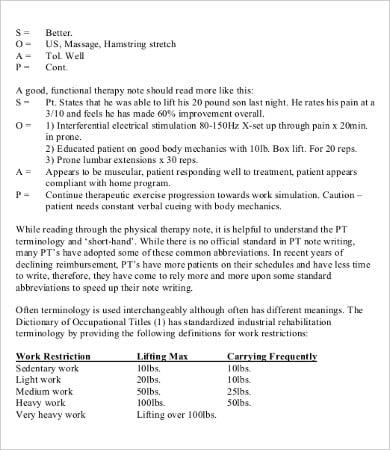
You don’t always need to go through each activity you did one-by-one and make your interpretation unless it’s very relevant to know.
#Soap notes upgrade#
You can note how the patient tolerated the activity, if they did better on it than they did last time, if they struggled when attempting it, if they completed it with no assistance and you needed to upgrade the task, etc. For the assessment, you will use your clinical judgment and reasoning skills to make a determination on the patient’s progress. This is where all that OT schooling comes into play. But leave the interpretation for the next section! A – Assessment

#Soap notes mod#
For notes that talk about assist levels (you know: min A, mod A, max A), it is appropriate to integrate these alongside the interventions. This may also include the amount of time certain activities are completed for, which is helpful if you are working on skills like activity tolerance or sensory integration. This is also a good place to add numbers to quantify these skills, when appropriate.įor example, if you are working with a child on a scavenger hunt, it’s good to add that they found 11/13 items. This shows the planning and forethought behind the activity, which is the more important part. Instead of listing an Uno game, it may be better to say that you led the patient in playing a card game addressing executive functioning and motor planning. It’s more important to include specifics on the skill that each part of the treatment targets rather than exactly what the activity is. Some therapists get tripped up with too many details here. It focuses on exactly what you provided to the patient. Unlike the first section, this section is fact-based. Under the objective heading, therapists will include the activities they did. This will help document whether certain interventions helped their pain or made it worse.) O – Objective (If patients present to therapy with a lot of pain, it’s a good idea to ask for their levels again later in the session and include this in your SOAP note. It’s best to ask the patient to report how intense their pain is using the visual analog scale (VAS), which rates their pain on a scale of 1 to 10. You want to be detailed, especially in regards to pain. This may include new or ongoing symptoms. How did the patient seem when you approached them or they arrived for therapy? If patients report any pain, swelling, stiffness, or other symptoms, you will want to include this. This is where therapists will include information about the patient’s demeanor, mood, or any changes in their medical status. A SOAP note consists of the following four components: S – Subjective This note is similar to the SBAR in that the structure is easy to remember and follows the headings in its name.

The most common note among occupational therapists is the SOAP note. Nursing professionals often use SBAR notes, which detail a situation, pertinent background, their assessment, and subsequent recommendations. For example, school-based therapists are responsible for writing lengthier progress notes called IEP reports as per a student’s individualized education plan (IEP). One is narrative format, which is the norm in mental health or community-based settings. Session notes, also called daily notes since they are completed after each patient visit, are mainly a way to document the activities a therapist does with a patient and how they respond. This is ideal for the sake of time and productivity, but it’s also the best way to convey the information you need.Ī variety of people like administrators, insurance companies, and doctors may look at your notes, and they will not want to sift through too much verbiage to get to what they’re looking for. This requires a therapist to add interpretations using their clinical lens.Ĭlinical judgment may sound complicated but, unlike many assignments in OT school, documentation is intended to be short and to-the-point. The main goal of any kind of documentation is to keep a record of the patient’s progress toward their goals and their remaining deficits. But the reality of writing an occupational therapy SOAP note, and other documentation, in the clinic is actually a lot simpler than it sounds. Documentation can be a pretty intimidating class in OT school.


 0 kommentar(er)
0 kommentar(er)
